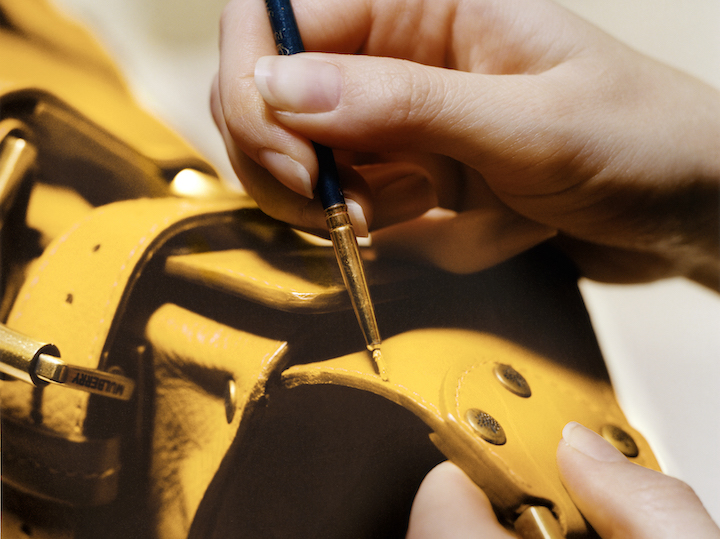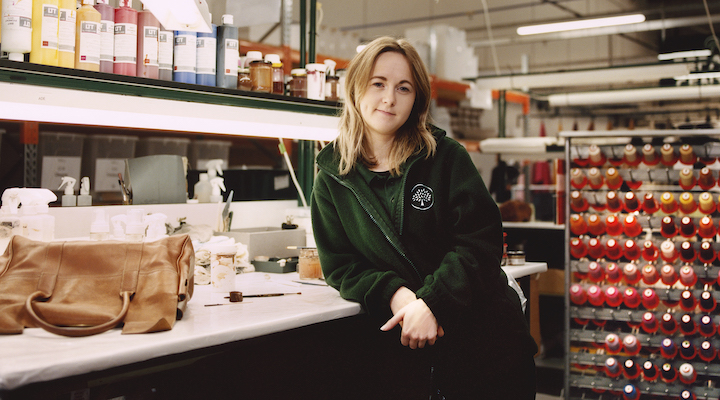Luxury label Mulberry, in a nod to World Earth Day and its own 50th anniversary, has launched an initiative called Made to Last Manifesto in which it commits to transform the business into a “regenerative and circular model”.
The plan is to look at “every part of our supply chain – from field to wardrobe” by 2030 to embed principles of regeneration and circularity at every stage as the company seeks to prove that leather can be sustainable.
At the core of the program is to extend the life of every bag it sells by committing to repair or buy them back, then resell or repurpose them. Mulberry also plans to develop the world’s lowest carbon leather, sourced from a network of environmentally conscious farms.

The company is also committed to achieve net zero carbon emissions by 2035 and to extend its commitment to being a real Living Wage employer by working with its network of suppliers to achieve the same.
“At Mulberry we have already taken significant action to embed sustainability across our business, but today we offer our commitment to a program of transformative change, embedding principles of regeneration and circularity across our entire supply chain,” said CEO Thierry Andretta, announcing the project to coincide with World Earth Day.
“We are committed to creating a hyper-local, hyper-transparent ‘farm to finished product’ sourcing model and whilst we are at the beginning of this transition, I am immensely proud of my colleagues and the work done to launch the Made to Last Manifesto. We look forward to the challenges ahead.”
Acknowledging the issues with cattle farming
Along with the commitment, the company has had to embrace some harsh truths – openly acknowledging the environmental issues associated with cattle farming, to produce leather.
Mulberry says it believes the “continuation of a long and successful association with leather” is dependent on achieving full traceability from farm to finished product. The company plans to develop a network of organic and environmentally conscious farms to supply the hides that create its leather by 2030.
Mulberry says its Somerset UK factories are carbon neutral and every person working in them is paid a real Living Wage.
“But, proud as we are of these achievements, we know we have to go much further to make transformational change, and that’s why we are asking the question, ‘Can you make a blue bag green?’.”
It believes so: this year the company will release its first locally made ‘farm to finished product’ bags using the world’s lowest-carbon leather.
“This collection will represent the future of the business, establishing a model that can be replicated with a network of trusted partners and underpins our commitment to reaching net zero carbon emissions by 2035,” the company said in a statement.
“Our transformative approach to leather sourcing will be reflected in the way we innovate new solutions across our business, from integrating recycled nylon and regenerative organic cotton into our products to continuously assessing and reducing the environmental impact of our packaging and our physical store network.”
Can you teach an old bag new tricks?
In asking, ‘Can you teach an old bag new tricks?,’ Mulberry has committed to extending the life of every one of its products through repair, renewal, and repurposing. “This commitment is at the heart of our circular proposition, influencing the way we design and manufacture, and the services we offer our customers.”
At The Rookery, one of the company’s factories, a dedicated repair team breath new life into more than 10,000 bags every year, with leather and hardware archives going back over 35 years.
“Through the Mulberry Exchange we match authenticated and beautifully restored classics with a new owner, and every one of our bags, be they 50 years or five months old, can find a second, third or even fourth home with another member of the Mulberry community,” the label explains. “This platform was launched in stores in 2020 and went digital on mulberry.com in April 2021, alongside a recently launched partnership with Vestiaire Collective, making resale a core pillar of Mulberry’s circularity strategy.
“If the day comes that a Mulberry bag really has reached the end of the line, we will still buy it back and using an innovative energy reclaim system, unique to our strategic partner Muirhead, a member of the Scottish Leather Group, power the production of a new bag, ensuring that the line never ends, it just becomes a circle.”
Mulberry launched its Made to Last campaign by bringing such questions and more to life vividly through a series of portraits, images and interviews with internal and external advocates for the regenerative and circular approach that the manifesto promises.
Those advocates include chef, restaurateur and soil activist Gizzi Erskine; artist, writer and entrepreneur Wilson Oryema; sustainable advocate and founder of Yehyehyeh, Shaway Yeh, as well as environmental and agricultural specialists, craftspeople from its factories, and more, who each engage in the key questions the manifesto asks.
“The Made to Last Manifesto promises that the Mulberry business and a Mulberry bag represent a commitment to regeneration, renewal and reimagination. Keeping this promise requires a culture change across the industry, the supply chain and amongst customers, a radical shift in both the way things are made and the way they are used, and it ultimately leads us to ask the question: ‘Can a bag save the world?’.
“We know real change is born from a willingness to ask ourselves the hard questions and to keep seeking meaningful answers. Can a Mulberry bag come with a promise of regeneration, renewal and reimagination? If it can, and we believe it can, then yes, a bag can truly be part of making things better,” Mulberry concluded.



